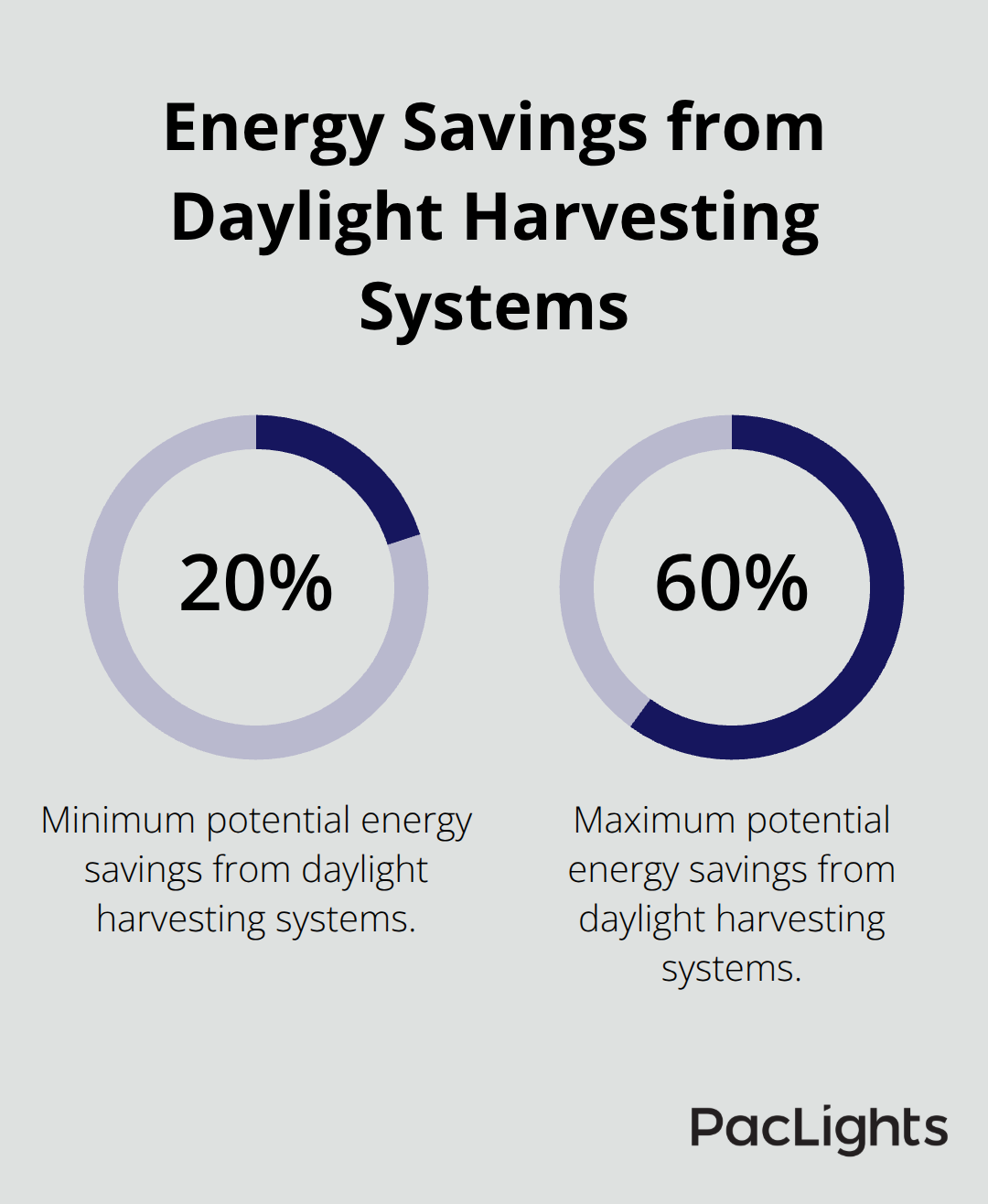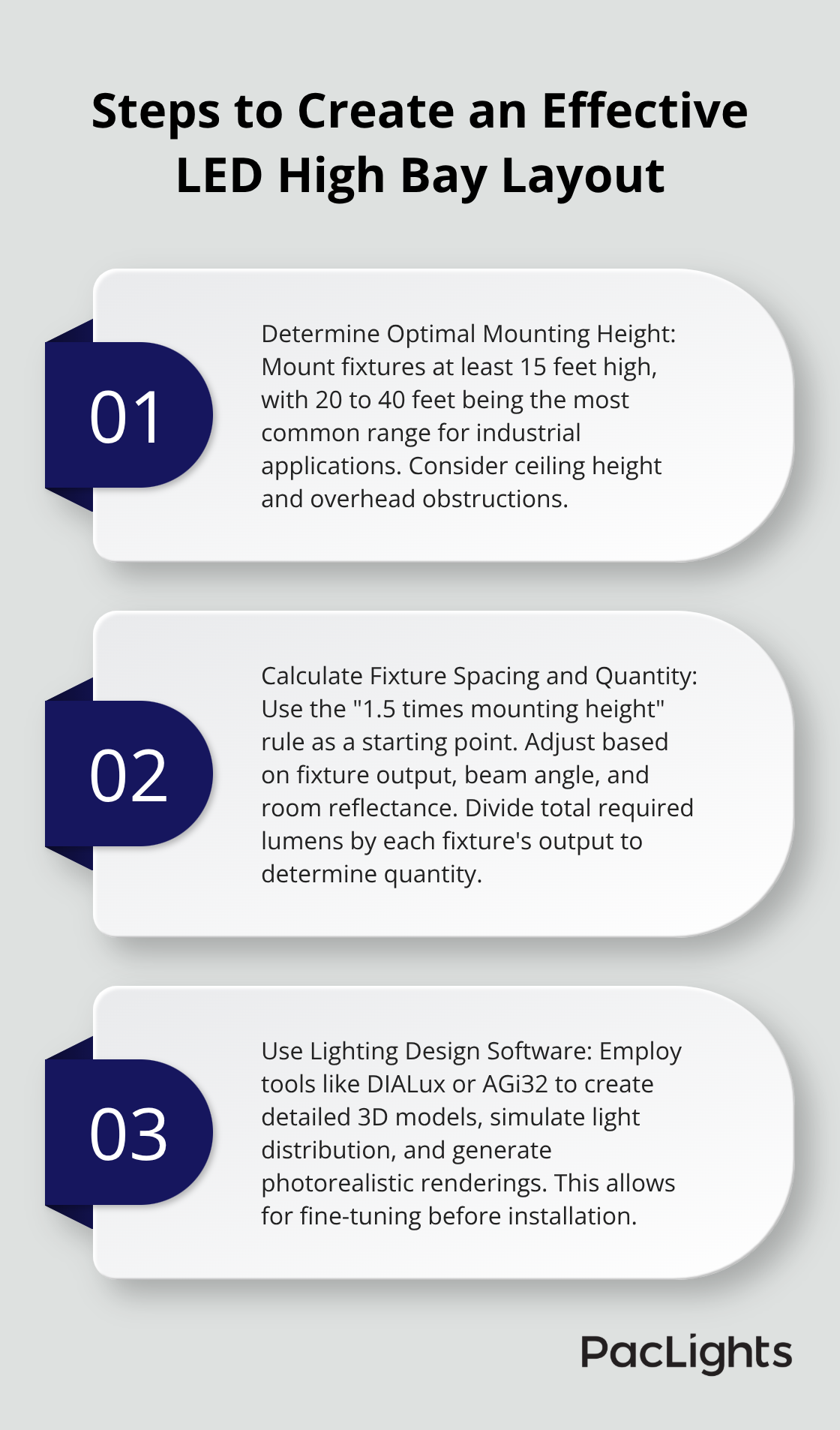Designing an effective LED high bay lighting layout is crucial for optimizing illumination in large commercial spaces. At PacLights, we understand the importance of proper lighting design for warehouses, factories, and other high-ceiling environments.
Our guide will walk you through the essential steps, from understanding lighting requirements to creating an efficient layout using an LED high bay lighting layout calculator. We’ll help you achieve optimal light distribution, energy efficiency, and visual comfort in your facility.
What Are LED High Bay Lighting Requirements?
Space Purpose and Light Levels
LED high bay lighting requirements vary based on the specific space and its intended use. The first step in designing your lighting layout is to define the purpose of your space. A warehouse needs different lighting than a gymnasium or a retail store. For example, a storage area might need 10-20 foot-candles, while a manufacturing floor could require 30-50 foot-candles for detailed work.
To calculate the required light levels in lumens, multiply the desired foot-candles by the square footage of your space. For instance, a 10,000 square foot warehouse aiming for 30 foot-candles would need 300,000 lumens (10,000 x 30). This calculation provides a starting point for selecting fixtures and determining their quantity.
Uniformity and Glare Control
Uniform lighting is essential for safety and productivity. The Illuminating Engineering Society (IES) recommends a uniformity ratio of 1.5:1 or better for most industrial applications. This means the brightest areas should be no more than 1.5 times brighter than the darkest areas.
Glare can cause discomfort and reduce visibility, especially in spaces with reflective surfaces. To mitigate glare, use fixtures with lower brightness and wider beam angles. For very high ceilings (over 30 feet), fixtures with narrower beam angles might be necessary to ensure light reaches the work plane effectively.
Environmental Factors
Environmental conditions significantly impact lighting design. Dust, moisture, and temperature fluctuations can affect fixture performance and lifespan. In food processing areas, NSF-certified fixtures are essential. For dusty or damp environments, look for fixtures with an IP65 rating or higher to ensure durability and safety.
Natural light also impacts your lighting needs. Skylights or large windows can reduce the artificial lighting required during daylight hours. Incorporating daylight harvesting systems can lead to energy savings of 20-60% (according to the Department of Energy).

Lighting Controls for Optimization
Integrating lighting controls can significantly enhance the efficiency of your high bay lighting system. Occupancy sensors can reduce energy use by up to 30% in low-traffic areas. Dimming capabilities allow for adjusting light levels based on tasks or time of day, further optimizing energy use and worker comfort.
Each space is unique when it comes to LED high bay lighting requirements. While these guidelines provide a solid foundation, consulting with lighting professionals ensures your design meets all specific requirements and regulations for your industry and location. The next step in creating an effective LED high bay lighting layout is selecting the right fixtures for your space.
How to Choose the Best LED High Bay Fixtures
Selecting the right LED high bay fixtures is essential for creating an effective lighting layout. This guide will walk you through the key factors to consider when choosing fixtures for your space.

Lumen Output and Efficacy
The lumen output of your fixtures determines how bright your space will be. For high bay applications, fixtures typically range from 15,000 to 60,000 lumens. Efficacy, measured in lumens per watt, is equally important. Try to find fixtures with high efficacy ratings (ideally above 130 lumens per watt) to maximize energy efficiency.
A 200W LED high bay fixture producing 26,000 lumens has an efficacy of 130 lumens per watt. This level of efficiency can lead to significant energy savings compared to traditional lighting options.
Color Temperature Considerations
Color temperature affects both the appearance and functionality of your space. Most industrial applications prefer cooler color temperatures between 4000K and 5000K. These temperatures enhance visibility and promote alertness, which is important for safety and productivity in work environments.
Some spaces may benefit from warmer color temperatures. Retail areas, for instance, might use 3000K-3500K fixtures to create a more inviting atmosphere. Always consider the specific needs of your space when selecting color temperature.
Beam Angles and Light Distribution
The beam angle of your fixtures significantly impacts light distribution. Spaces with high ceilings (30 feet or more) need narrower beam angles (60-90 degrees) to ensure light reaches the work plane effectively. Lower ceilings or wider coverage areas require fixtures with beam angles of 120 degrees or more to provide even illumination.
Many modern LED high bay fixtures offer adjustable beam angles, allowing for fine-tuning of light distribution after installation. This feature can be particularly useful in spaces with varying ceiling heights or changing layout needs.
Use lighting design software to simulate different fixture placements and beam angles. This approach helps optimize light distribution and minimize dark spots or overlapping illumination.
Durability and Lifespan
Durability is a critical factor in high bay lighting, especially in industrial environments. Look for fixtures with robust construction, preferably made from materials like die-cast aluminum (which offers excellent heat dissipation and longevity).
IP ratings are also important. Most indoor industrial applications need fixtures with an IP65 rating or higher to protect against dust and moisture. Food processing areas or extremely wet environments might require fixtures with even higher IP ratings.
Quality LED high bay fixtures should offer a lifespan of at least 50,000 hours. Some manufacturers offer fixtures with lifespans up to 100,000 hours. A longer lifespan means less frequent replacements and lower maintenance costs over time.
Factor in warranty when assessing fixture durability. A comprehensive warranty not only provides peace of mind but also indicates the manufacturer’s confidence in their product’s longevity.
The next step in creating an effective LED high bay lighting layout involves designing the optimal arrangement of these carefully chosen fixtures.
How to Create an Effective LED High Bay Layout
Creating an effective LED high bay layout involves several key steps to ensure optimal illumination and energy efficiency. Here’s a guide to help you through the process:

Determine Optimal Mounting Height
The mounting height of LED high bay fixtures impacts light distribution and effectiveness. Mount fixtures at least 15 feet high, with 20 to 40 feet being the most common range for industrial applications.
For ceilings over 30 feet, use more powerful fixtures with narrower beam angles to ensure light reaches the work plane effectively. In spaces with lower ceilings (15-20 feet), fixtures with wider beam angles provide better coverage.
Tip: Measure the distance from the floor to the bottom of overhead obstructions (like HVAC systems or cranes) to determine your maximum mounting height.
Calculate Fixture Spacing and Quantity
Proper fixture spacing achieves uniform illumination. A common industry guideline is the “1.5 times mounting height” rule. For example, fixtures mounted at 30 feet should be spaced approximately 45 feet apart.
This rule isn’t universal. Factors like fixture output, beam angle, and room reflectance affect optimal spacing. For precise calculations, use this formula:
Spacing = √(Mounting Height x 2 x Coefficient of Utilization)
The Coefficient of Utilization (CU) typically ranges from 0.6 to 0.8 for most industrial spaces. Higher CU values indicate better light utilization and allow for wider spacing.
To determine the number of fixtures needed, divide your total required lumens by the lumen output of each fixture. Then, adjust based on your spacing calculations to ensure even coverage.
Use Lighting Design Software
Lighting design software offers accurate and comprehensive results. These tools create detailed 3D models of your space, factoring in elements like walls, equipment, and reflective surfaces.
Software like DIALux or AGi32 simulates light distribution, calculates illuminance levels at different points, and generates photorealistic renderings of your space. This allows you to fine-tune your layout before installation, potentially saving time and resources.
Many lighting manufacturers (including PacLights) offer free lighting layout services using professional-grade software. These services can ensure you get the most optimized layout for your specific needs.
Incorporate Controls for Energy Savings
Strategic placement of occupancy sensors reduces energy waste in low-traffic areas. For large open spaces, consider zoning your lighting to allow for more granular control.
Daylight harvesting systems can be effective in spaces with skylights or large windows. These systems automatically adjust artificial lighting based on available natural light, potentially reducing energy costs by 20-60% (according to the Department of Energy).
When designing your layout, consider future flexibility. Choose fixtures and control systems that allow for easy reconfiguration as your space needs change over time.
Consider Unique Space Factors
Every space is unique. Factors like ceiling height, room shape, and specific task requirements impact the ideal layout. Consult with lighting professionals to ensure your design meets all specific requirements and regulations for your industry and location.
Final Thoughts
An effective LED high bay lighting layout optimizes visibility, safety, and energy efficiency in industrial spaces. Careful planning, precise calculations, and appropriate fixture selection form the foundation of a well-designed system. Professional lighting design services can provide invaluable expertise, utilizing tools like LED high bay lighting layout calculators to create tailored solutions.
We at PacLights offer a range of LED lighting products designed for various commercial and industrial applications. Our team provides free lighting layout designs and ROI assessments to help you make informed decisions about your lighting upgrade. These services can ensure your system meets relevant standards while maximizing energy efficiency.
A thoughtful LED high bay lighting layout contributes to a more sustainable, cost-effective, and productive work environment. As lighting technology advances, it’s important to stay informed and periodically reassess your lighting needs. This approach will help maintain an optimal lighting system for years to come.


Disclaimer: PacLights is not responsible for any actions taken based on the suggestions and information provided in this article, and readers should consult local building and electrical codes for proper guidance.